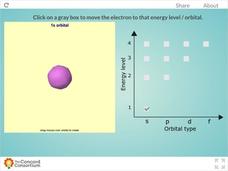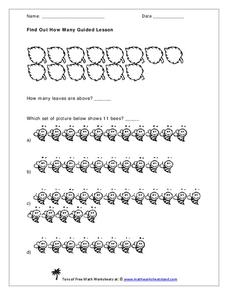Star Date
Modeling the Night Sky
Dramatize the stars and planets as they become a visual representation of the solar system in this activity. Young astronomers track and simulate various constellations as they orbit the Earth to learn the position and motion of objects...
Curated OER
Role Models
Sixth graders examine the characteristics of role models. In this biography instructional activity, 6th graders debate the qualities of role models. Students work individually to research a historical or modern role model and create a...
Curated OER
Hands-On Equations: Teacher Notes
Math manipulatives are wonderful for demonstrating any number of mathematical concepts in a concrete and visual way. Learners review the addition property of equality and the zero property using a scale model kit (not shown). They...
Curated OER
Understanding Visual Fractions
There is one visual fraction question here with an answer detailed below; consider projecting this as an all-class warm up, covering up the bottom until the class has offered their thoughts. Learners assess four fraction models to...
Curated OER
Model a Famous Painting in Friendly Plastic
Friendly Plastic is a fun art medium created by Amaco Clay Company. It is versatile and results in a beautiful end product. With this resource, young artists can recreate a famous painting using Friendly Plastic. What a fun way to study...
CK-12 Foundation
Sums of Mixed Numbers: Split the Addition
Five questions challenge scholars to add mixed numbers. A tool creates a visual model that separates whole numbers from fractions parts. Problem types include fill in the blank, true or false, and discussion.
Curated OER
Mapping Your Identity: A Back-To-School Ice Breaker
Identify the unique personal attributes of your class members. Begin by viewing the Visual Thesaurus and discussing displayed attributes associated with famous American leaders. Using these identity maps as models, pupils generate nouns...
Scholastic
What's Your Angle?
Identifying types of angles meets real-world application in an excellent, hands-on geometry activity. Learners use pipe cleaners and a visual model to independently discover the acute, right, or obtuse angles in their classroom, which...
Mathematics Vision Project
Module 5: Modeling with Geometry
Solids come in many shapes and sizes. Using geometry, scholars create two-dimensional cross-sections of various three-dimensional objects. They develop the lesson further by finding the volume of solids. The module then shifts to finding...
California Academy of Science
Moons in Comparison
Just how big is Earth's moon? With a hands-on simulation, scholars use Play-Doh to model the sizes of the planets Earth, Mars, Jupiter, and their moons. They make predictions as a class, work together to make their models, and discuss...
CK-12 Foundation
Area and Volume of Similar Solids: Similar Solids
Five questions make up an interactive designed to boosts knowledge of area and volume of solid figures. Question types include multiple-choice, true or false, and fill-in-the-blank. A scale model changes measurement to provide a visual...
Virginia Department of Education
Chemical Bonds
How are chemical bonds similar and how are they different? Provide your young chemists with the resources to more thoroughly understand the concepts of ionic and covalent bonds. Pupils research these topics, diagram examples of each...
National Nanotechnology Infrastructure Network
Wet Etching in Nanofabrication
Chemistry and physics combine forces to benefit nanofabrications. Learners examine the process of wet etching in nanofabrication. Using corrosive substances such as lemon juice and Coca-Cola, they model the etching process. They then...
Concord Consortium
Understanding Probability Maps
What's the likelihood of your class understanding probability maps? Young scientists explore the concept using a virtual dartboard in an interesting simulation. The darts establish a pattern around the bull's-eye, which provides a visual...
Concord Consortium
Energy Levels of a Hydrogen Atom
Tired of blowing up countless balloons to illustrate orbital shapes around an atom? Give your lungs a break and use an interactive instead! Learners observe s, p, d, and f orbitals through the first four energy levels using hydrogen as a...
Concord Consortium
Structure of an Atom
Feeling a little uncertain about your materials for teaching the quantum mechanical model of the atom? Here is an interactive that will help! Chemistry and physics scholars alike will benefit from a simple resource that illustrates the...
Curated OER
Cellular Models
Each student construct a model of a cell on a large cookie, including the parts which were discussed during lecture.? Half of the class will be instructed to make plant cell models and the other half will be in charge of animal cell...
Curated OER
Positive-Negative Charge Model For Integers
Use two different colors of bingo chips to represent positive and negative charges. Add and subtract them in a clear glass beaker to demonstrate how to add and subtract integers. This visual, along with a number line, will really help...
Curated OER
Addition Practice
Give your mathematicians a leg up on simple addition using this activity with visual aids. Similar to counting cubes, each single-digit addend is accompanied by a corresponding number of colored squares. The two colors are joined where...
Curated OER
Addition Word Problems Up to 20
Because this addition word problem has the answer written on the same page, consider using it as a warm-up and projecting it. Simply cover up the answer until you're ready. The problem has beginners adding up two single-digit numbers for...
Curated OER
How Many?
Do this as a whole-class activity by projecting this simple counting worksheet. Learners count a set of 14 leaves, recording the total number. Then, they examine four sets of bees and indicate which one shows 11. This can be done...
Curated OER
Division Word Problems
Use visual aids to help mathematicians who are new to division. They examine a word problem, using a picture for guidance. Because this has the answer explained below, it is ideal as an all-class warm up. Cover up the bottom as the class...
Curated OER
Represent a Fraction on a Number Line
Have scholars represent these fractions by drawing a number line for each. They segment the number line based on the denominator, then mark an x based on the numerator. Do one of these together before sending pupils off to do this on...
Curated OER
Real-Life Problems
Introduce scholars to addition and subtraction word problems with visual guidance. There are five scenarios here, each with a picture to guide scholars as they solve. An example encourages kids to physically interact with the images,...

























